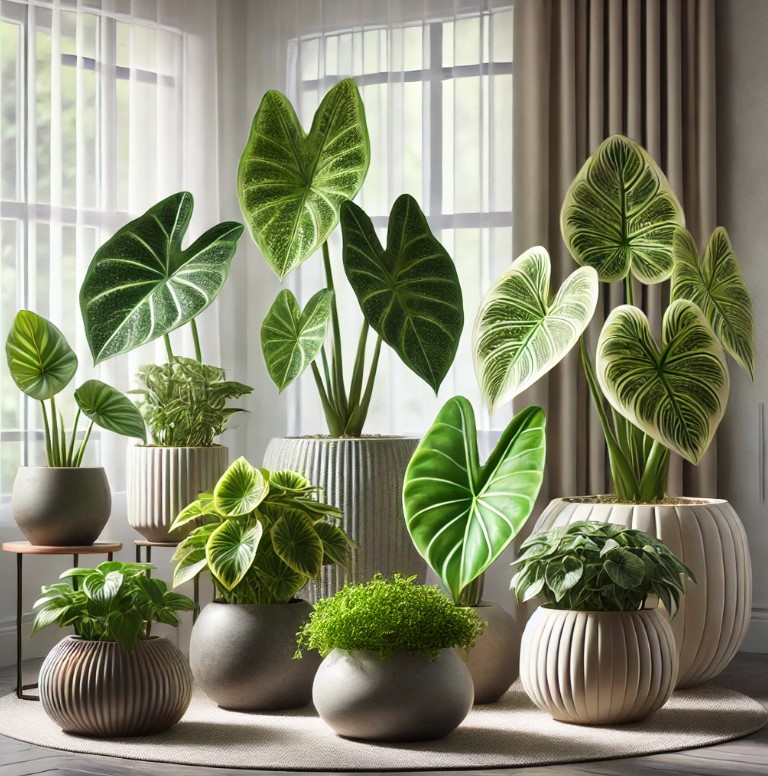Alocasia are known for their dramatic form, foliage, and a true favorite among indoor exotic plant lovers. From the common Alocasia Polly to the occasional Alocasia Frydek, knowing how to properly care for your plants will help provide them with a thriving home. This guide will take you through necessary tips for how to keep Alocasia plants healthy based on their specific requirements. We will guide you through all the knowledge necessary to create a home for your Alocasia: ranging from light and watering needs to finding the perfect medium. Read on for practical care tips to help keep your plants healthy and thriving.
1. Quick Facts About Alocasia
Alocasia is a genus of tropical plants, typically characterized by their large, shiny leaves with interest-inducing colors and textures. Alocasia comes in different types, but they all share something special. Alocasia Polly, Alocasia Frydek and Alocasia Amazonica are the most popular cultivars.
2. How to Decide What Alocasia is right for Your Home
Choose an Alocasia based on lighting, space, and the level of care each variety needs. For instance, Alocasia Polly prefers a medium to bright light, but Alocasia Amazonica needs indirect light as it can be sunburned easily.
3. Light Needs of Alocasia Plants
Most Alocasia plants actually like bright, indirect light. The leaves can be scorched by direct sunlight and within the scope as insufficient light may lead to weak growth. Your Alocasia will be well-lit in filtered light or close to a window but kept behind sheer curtains.
4. Best Soil Type for Alocasia
Alocasia plants love a potting mix that drains well. They prefer soil that remains moist but dries out after waterings to prevent root rot. For most Alocasia, a peat-perlite-orchid bark soil mix works nicely.
5. Proper Watering Techniques
When it comes to watering, Alocasia plants are very sensitive to both overwatering and underwatering. Allow the top inch of soil to dry out before watering, and do not let it sit in water. Make sure the pot you are using has holes in the bottom so any excess water can drain.
6. Humidity Preferences
Because Alocasia is a tropical plant, they do well in high humidity. You can mist the leaves often or keep a tray of water nearby, or you could run a humidifier to make sure that it gets enough moisture.
7. Thermostats Required For Good Growth
When it comes to temperature, Alocasia like it warm with good humidity between 65°F and 80°F (18°C to 27°C). Never put them out next to cold draughts or air conditioning, since this will cause the plant lots of stress and hinder growth.
8. Fertilization Advice for Your Plants: How To Keep Foliage Nice And Green
During the growing season (spring and summer), feed your Alocasia a balanced, water-soluble fertilizer. In the fall and winter when your plant’s growth is slowing down, you should cut back on feeding it. Too much fertilizer can lead to a nutrient imbalance.
9. Repotting Your Alocasia
Most Alocasia will need to be repotted once every one, to two years. Pick a pot 2-3 inches larger than the one you are in to give the roots space to grow. The best time to repot is in the spring when the plant is coming into its growing season.
10. Managing Pests and Diseases
Alocasia is prone to pests namely spider mites, aphids, and mealybugs. Monitor for pests on undersides of leaves, and treat any infestations quickly with insecticidal soap or neem oil.
11. Pruning and Maintenance
Trim off any dead or damaged foliage to promote health. It is vital to avoid unwanted stress on Alocasia plants, so all pruning should be done with clean sharp shears to minimize damage.
12. Symptoms of Too Much Water and Root Rot
Alocasia care can be tricky but one of the most common problems found with plants. The classic signs of overwatering are yellow leaves, potted plants wilting and the soil smells bad. Proper drainage is essential in preventing root rot, so make sure to allow the topsoil to dry out in between waterings.
13. Common Growth Problems and Their Solutions
If your Alocasia is not growing well, it could be caused by low light, overwatering or temperature stress. Adjust watering schedules accordingly and make sure that the plant is still receiving enough indirect sunlight.
14. Caring for Alocasia Plants in Winter
Alocasia plants might enter dormancy during the winter months. Water less and do not fertilize to avoid stressing the plant. Place the plant in a warm room with sufficient light to stimulate active growth when spring arrives.
15. Where to Buy Alocasia Plants
Alocasias are often tricky to find, but there are quite a few different types for sale online in addition to local nurseries. Find those reliable sellers that focus on rare and exotic houseplants.
Welcome to our guide on Alocasia plants — the only resource you will ever need to grow your Alocasia and keep them alive in your home! Everything from soil and lighting to pest management, these indoor gardening tips will have you ready for success!
